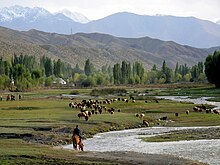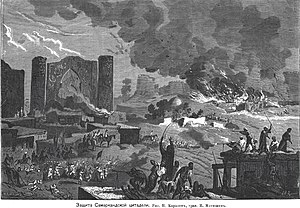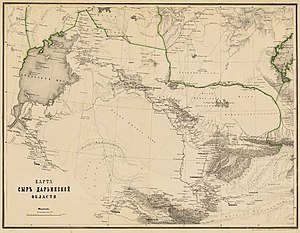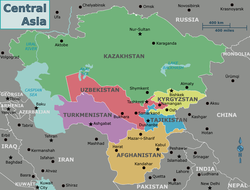

| Russian Turkestan
Русский Туркестан
| |||||||||||||||
|---|---|---|---|---|---|---|---|---|---|---|---|---|---|---|---|
| Governorate−General of Russian Empire | |||||||||||||||
| 1867–1917 | |||||||||||||||
|
Coat of arms | |||||||||||||||
 Provinces of Russian Turkestan in 1900 | |||||||||||||||
| Anthem | |||||||||||||||
| Bozhe, Tsarya khrani! Боже, Царя храни! "God Save the Tsar!" | |||||||||||||||
| Capital | Tashkent | ||||||||||||||
| Demonym | Turkestani | ||||||||||||||
| Area | |||||||||||||||
• (1897)
| 1,707,003 km2 (659,078 sq mi) | ||||||||||||||
| Population | |||||||||||||||
• (1897) | 5,280,983 | ||||||||||||||
| History | |||||||||||||||
• Established | 23 July 1867 | ||||||||||||||
| 1917 | |||||||||||||||
| Political subdivisions | Oblasts: 5 (since 1899) | ||||||||||||||
| |||||||||||||||
| Today part of | Kazakhstan Kyrgyzstan Tajikistan Uzbekistan Turkmenistan | ||||||||||||||
Russian Turkestan (Russian: Русский Туркестан, romanized: Russkiy Turkestan) was the western part of Turkestan within the Russian Empire’s Central Asian territories, and was administered as a KraiorGovernor-Generalship. It comprised the oasis region to the south of the Kazakh Steppe, but not the protectorates of the Emirate of Bukhara and the Khanate of Khiva. It was populated by speakers of Russian, Uzbek, Kazakh, Kyrgyz, and Tajik.
Part of a series on the
|
|||||||||||||||||||||
|---|---|---|---|---|---|---|---|---|---|---|---|---|---|---|---|---|---|---|---|---|---|
| History of Central Asia | |||||||||||||||||||||
 | |||||||||||||||||||||
|
|||||||||||||||||||||
|
|||||||||||||||||||||
|
Topics |
|||||||||||||||||||||
|
|
Part of a series on the
|
||||||||||||||||||||||
|---|---|---|---|---|---|---|---|---|---|---|---|---|---|---|---|---|---|---|---|---|---|---|
| History of Kazakhstan | ||||||||||||||||||||||
 | ||||||||||||||||||||||
|
||||||||||||||||||||||
|
||||||||||||||||||||||
|
Topics |
||||||||||||||||||||||
|
Other |
||||||||||||||||||||||
|
|


Although Russia had been pushing south into the steppes from Astrakhan and Orenburg since the failed Khivan expeditionofPeter the Great in 1717, the beginning of the Russian conquest of Turkestan is normally dated to 1865. That year the Russian forces took the city of Tashkent[1] under the leadership of General Mikhail Chernyayev expanding the territories of Turkestan Oblast (part of Orenburg Governorate-General). Chernyayev had exceeded his orders (he only had 3,000 men under his command at the time) but Saint Petersburg recognized the annexation in any case. This was swiftly followed by the conquest of Khodzhent, Dzhizak and Ura-Tyube, culminating in the annexation of Samarkand and the surrounding region on the Zeravshan River from the Emirate of Bukhara in 1868 forming the Zeravsh Special Okrug of Turkestan.
An account of the Russian conquest of Tashkent was written in "Urus leshkerining Türkistanda tarikh 1262–1269 senelarda qilghan futuhlari" by Mullah Khalibay Mambetov.[2][3]
In 1867 Turkestan was made a separate Governor-Generalship, under its first Governor-General, Konstantin Petrovich von Kaufman. Its capital was Tashkent and it consisted initially of three oblasts (provinces): Syr Darya, Semirechye Oblast and the Zeravshan Okrug (later Samarkand Oblast). To these were added in 1873 the Amu Darya Division (Russian: отдел, otdel), annexed from the Khanate of Khiva, and in 1876 the Fergana Oblast, formed from the remaining rump of the Kokand Khanate that was dissolved after an uprising in 1875. In 1894, the Transcaspian Region (which had been conquered in 1881–1885 by military generals Mikhail Skobelev and Mikhail Annenkov) was added to the Governor-Generalship.
The administration of the region had an almost purely military character throughout. Von Kaufman died in 1882, and a committee under Fedor Karlovich Giers (or Girs, brother of the Russian Foreign Minister Nikolay Karlovich Giers) toured the Krai and drew up proposals for reform, which were implemented after 1886. In 1888 the new Trans-Caspian railway, begun at Uzun-Ada on the shores of the Caspian Sea in 1877, reached Samarkand. Nevertheless, Turkestan remained an isolated colonial outpost, with an administration that preserved many distinctive features from the previous Islamic regimes, including Qadis' courts and a 'native' administration that devolved much power to local 'Aksakals' (Elders or Headmen). It was quite unlike European Russia. In 1908 Count Konstantin Konstantinovich Pahlen led another reform commission to Turkestan, which produced in 1909–1910 a monumental report documenting administrative corruption and inefficiency. The Jadid educational reform movement which originated among Tatars spread among Muslims of Central Asia under Russian rule.
A policy of deliberately enforcing anti-modern, traditional, ancient conservative Islamic education in schools and Islamic ideology was enforced by the Russians in order to deliberately hamper and destroy opposition to their rule by keeping them in a state of torpor to and prevent foreign ideologies from penetrating in.[4][5]
The Russians implemented Turkification upon the Ferghana and Samarkand Tajiks, replacing their language with Uzbek, resulting in a dominantly Uzbek-speaking Samarkand, whereas decades before Tajik Persian was the dominant language in Samarkand.[6]
In 1897 the railway reached Tashkent, and finally in 1906 a direct rail link with European Russia was opened across the steppe from Orenburg to Tashkent. This led to much larger numbers of ethnic Russian settlers flowing into Turkestan than had hitherto been the case, and their settlement was overseen by a specially created Migration Department in Saint Petersburg (Переселенческое Управление). This caused considerable discontent amongst the local population as these settlers took scarce land and water resources away from them. In 1916 discontent boiled over in the Basmachi Revolt, sparked by a decree conscripting the natives into labour battalions (they had previously been exempt from military service). Thousands of settlers were killed, and this was matched by Russian reprisals, particularly against the nomadic population. To escape Russians slaughtering them in 1916, Uzbeks, Kazakhs and Kyrgyz escaped to China.[7] Xinjiang became a sanctuary for fleeing Kazakhs escaping the Russians after the Muslims faced conscription by the Russian government.[8] The Turkmen, Kyrgyz, and Kazakhs were all impacted by the 1916 insurrection caused by the conscription decreed by the Russian government.[9][10] The corvée conscription issued on June 25, 1916.[11] Order had not really been restored by the time the February Revolution took place in 1917. This would usher in a still bloodier chapter in Turkestan's history, as the Bolsheviks of the Tashkent Soviet launched an attack on the autonomous Jadid government in Kokand early in 1918, which left 14,000 dead. Resistance to the Bolsheviks by the local population (dismissed as 'Basmachi' or 'Banditry' by Soviet historians) continued well into the beginning of the 1930s.
Turkestan had 21 Governor-generals.[12]

Turkestan was divided into five oblasts.

After the Russian Revolution of 1917, a Turkestan Autonomous Soviet Socialist Republic (Turkestan ASSR) within the Russian Socialist Federative Soviet Republic was created in Soviet Central Asia (excluding modern-day Kazakhstan). After the foundation of the Soviet Union it was split into the Turkmen Soviet Socialist Republic (Turkmenistan) and Uzbek Soviet Socialist Republic (Uzbekistan) in 1924. The Tajik Soviet Socialist Republic (Tajikistan) was formed out of part of the Uzbek SSR in 1929, and in 1936 the Kyrgyz SSR (Kyrgyzstan) was separated from Kazakh Soviet Socialist Republic. After the collapse of the Soviet Union, these republics gained their independence.
|
| ||||||||||
|---|---|---|---|---|---|---|---|---|---|---|
| History |
| |||||||||
| Geography |
| |||||||||
| Politics |
| |||||||||
| Economy |
| |||||||||
| Culture |
| |||||||||
|
| ||||||||||
| Authority control databases: National |
|
|---|